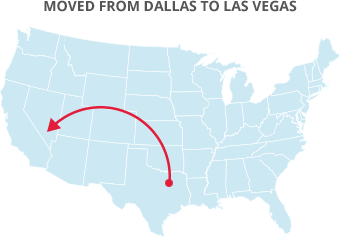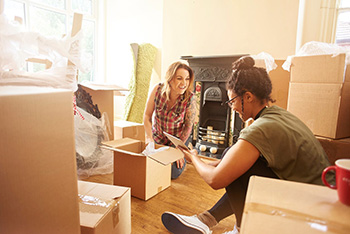

 There is something about a big pile of boxes and spools of packing tape that is rejuvenating—here is your excuse to sift through all your stuff and meticulously box your valuables, so when you reach your new home and begin unpacking the boxes it will seem just like your birthday when you were a kiddo. Imagine for a moment that's how the entire sequence of events truly unfolds, and you're not running around the abode like a crazy person throwing heirloom china in with the set of encyclopedias, make sure you have the correct packing supplies for your moving task.
There is something about a big pile of boxes and spools of packing tape that is rejuvenating—here is your excuse to sift through all your stuff and meticulously box your valuables, so when you reach your new home and begin unpacking the boxes it will seem just like your birthday when you were a kiddo. Imagine for a moment that's how the entire sequence of events truly unfolds, and you're not running around the abode like a crazy person throwing heirloom china in with the set of encyclopedias, make sure you have the correct packing supplies for your moving task.
Boxes and tape are a few of the most important components of packing, but all boxes and tape are NOT similar in quality. It is okay to throw some coffee mugs in an old microwave box and put it in the top of the pantry, but to pack, stack, and move that box, it will fall down like a house of cards and you'll end up with a lot of broken ceramic pieces.
If you're packing yourself, do some research into the materials prior to getting started. If you're hiring a moving company to execute the actual moving, they will probably have the correct heavy-duty boxes, tape, and wrapping stuff you'll want to use. If not, storage facilities, big box stores, and the internet are acceptable sources to obtain your supplies, but since you cannot do tactile research over the internet, don't rely on reviews to help you—everyone packs differently and "sturdy" and "solid" are very subjective words.
Look for boxes that are corrugated--a layer of wavy fiber between the inner and outer layers of heavy cardboard. The corrugated gives the box structure and support, so when you put them on the truck they don't cave in. There are different degrees of toughness within the corrugated realm, so you should get the box strength you need for a particular item--go with the most rugged boxes for the most fragile and the bulkiest things you'll pack.
While you're purchasing boxes, load up on the small ones--heavy belongings go in small boxes, bulky lightweight things go in the larger boxes. For instance, books weigh quite a bit and should be put in a small box. Blankets and throw pillows are comparatively light and go in the bigger ones.
Purchasing cheap, low quality tape is where lots of DIY movers get discouraged. If it is cheap, it won't adhere well. Worse, it will stick to itself when it is dispensed out of the gun and splinter in small little pieces and then you have to pick off the needle end and try to get it to unstick in a single piece. Splurge on a good-quality gun or two with a padded handle—you'll be overjoyed you did when you are seventy-five boxes in with a hundred more to go. It's also a good idea to buy your tape in bulk--it costs less and you can usually return what you might not use.
 There are lots of options for padding inside the boxes. Old towels and blankets are magic when you require something lining the box, for example when you're packing shoes and do not want them banging around.
There are lots of options for padding inside the boxes. Old towels and blankets are magic when you require something lining the box, for example when you're packing shoes and do not want them banging around.
Newsprint is definitely the best alternative for pretty much everything--from packing mugs (thread a twisted end through the handle and stick the other ends inside once it's wrapped) to books to small appliances.
Bubble wrap can be expensive, but buy the good stuff anyway, since those are the items that you will use it for. The bubble size fluctuates, but a fair guideline is for your bubble size to couple the item size—use the big bubbles for lining around the entire box. Touch the wrap before you buy, and observe how strong it is when you twist and pull it. If it's weak or doesn't feel like the bubbles hold, try another brand.
If you have not moved for a while, and you go hunting for boxes, be ready to be astounded at the options you have. When your parents moved, they probably bought their tape and boxes and had the whole neighborhood saving newspapers for a long time. Now, there are bunches of specialty moving supplies you'll see when you go shopping—some are actually worth the extra expense, some are just reinventing the wheel—it's up to you to decide what is going to be best for your move. Again, make positive you are purchasing decent quality--you don't want your mattresses in flimsy plastic sheeting.
Now that you've got the smaller items under control, focus on how you are going to move the bulky items out the door--the dressers, the lawn mower, the grill--but don't fret, help is right around the corner. In order to move several of these things renting equipment is the best thing to do.
Your furniture is more susceptible to damage than you probably realize--surface dings and scrapes are entirely too common when things come off the truck. You can sidestep this damage with some simple protection; again, make sure you're buying or renting decent quality materials that hold up to a lot of wear and tear.
The last things you will require are for the big time heavy and bulky stuff. Unless you happen to have these items already, you’ll want.
No matter how you're actually transporting your residence, your local moving company will be able to provide you with all of the speciality items you will require to move. Just remember that you're moving your entire life in these boxes, so be sure that your moving supplies are sufficient for the job.

